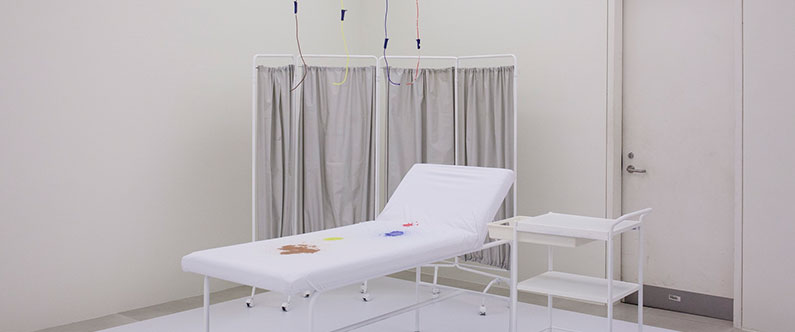VCUQatar and WCM-Q students launch ‘Art and Medicine’ exhibition
 The collaboration forced the students to think outside of their comfort zones and to learn from each other.
The collaboration forced the students to think outside of their comfort zones and to learn from each other.
The medical and artistic worlds collided as students of WCM-Q and Virginia Commonwealth University in Qatar (VCUQatar) presented their original artworks at a new exhibition that explores the intersection between art and medicine.
The month-long exhibition at the Hamad Bin Khalifa University Student Center showcases a collection of works created by six students from each college, utilizing a range of materials, methods and media, from laser-cut works based on medical scans, to photographs that examine the landscape as a metaphor for neurological conditions, and kinetic sculptures that question our perception of what is mental and what is physical.
The artworks and the exhibition are the result of a semester-long collaboration between VCUQatar and WCM-Q that sought to explore the many direct and abstract links that exist between art and medicine, as part of a research project conducted by Dr. Alan Weber, associate professor of English at WCM-Q; Rhys Himsworth, director of painting and printmaking at VCUQatar; Amy Andres, interim director of libraries and assistant professor at VCUQatar; and Dr. Stephen Scott, associate dean for student affairs at WCM-Q. Himsworth curated the exhibition and an exhibition catalogue and documentary film about the project will be published shortly.
Through an Art and Medicine Learning Laboratory set up by the researchers the project aimed to develop innovative, interdisciplinary pedagogies that will provide art students with new understandings, materials and tools to further develop their artistic practice, and which will also allow medical students to rethink medical decision-making and patient care.
The Learning Laboratory consisted of a series of workshops, seminars and lectures that investigated how each discipline solves problems, develops expertise, and utilizes creativity, analysis, synthesis, and evaluation to create new knowledge.
Dr. Weber said that the students had benefited from working with peers from a different discipline.
“Clearly, art and medicine are very different disciplines involving very different modes of learning, so the students have to move outside of their comfort zones and think creatively to develop ways to communicate and work productively with one another,” he said.
Through this process the students gained an entirely different perspective on learning, problem-solving, teamwork and creativity, which we feel has been enormously enlightening, both for the students themselves and for us as researchers interested in pedagogical innovation.”
VCUQatar student Emelina Soares worked with WCM-Q student Yanal Shaheen to create a sculpture that explores the fragile nature of human skin. She said:
“At first it was challenging to pursue a project with a medical student, since both our thoughts have complex directions in regards to rationalizing a final outcome. The medical students are trained to think structurally in order to define circumstances, while we emphasize on an imaginative and conceptual approach to the world. However, the course materials gave us both the opportunity to encounter both disciplines and discover a common ground to realize our final work.
One of my main interests is the depiction of death in religious art, which has a fairly clear link to medicine and its study of human anatomy. This common interest really helped Yanal and I to develop our sculpture.”
The researchers have documented the interactions between the students through photography, videography and ethnographic-based research methodologies.
The research project is the product of collaboration and support from WCM-Q, VCUQatar, Hamad Medical Corporation, Qatar Science and Technology Park, Hamad Bin Khalifa (HBKU) Student Center, Qatar Robotics Institute of Development, and the Qatar Robotic Surgery Center. Himsworth said:
“In order to understand, comment upon, and critique contemporary culture artists must use the tools of their time. These will include traditional media we associate with artistic practice but increasingly include new media such as robotics, biological materials, and computer algorithms. Interestingly, these are also areas of interest to medical practitioners and there exists a great opportunity for artists to collaborate with scientists.
By working together in a project such as 'art and medicine' we hope that young artists are exposed to new collaborative opportunities that will allow them to create works that provide a greater understanding and more vivid account of contemporary issues.”
Professor Andres added:
“We wanted to cultivate a mutually insightful, disciplinary transfer of information and ideas that would bridge the gulf between the arts and sciences by bringing science directly into art and design. We strove to create scenarios in which the students from the medical sciences could bring their knowledge and skill sets to the conceptualization and design of art works. We also believed it was important to create such an opportunity in Qatar, a country that has demonstrated its commitment to education, interdisciplinary collaboration, and creative production.”
The exhibition can be viewed at the HBKU Student Center from April 12 to May 14. Opening hours are Sunday to Thursday 10am – 9pm, Friday 2pm – 9pm.
WCM-Q Student Artists
Mu Ji Hwang
Farah Al Sayyed
Faryal Malick
Rebal Turjoman
Eman Mosleh
Yanal Shaheen
VCUQatar Student Artists
Noor Al-Thani
Habeeb Abu-Futtaim
Abdul Rahman
Mohammad Jawad
Amelie Beicken
Emelina Soares